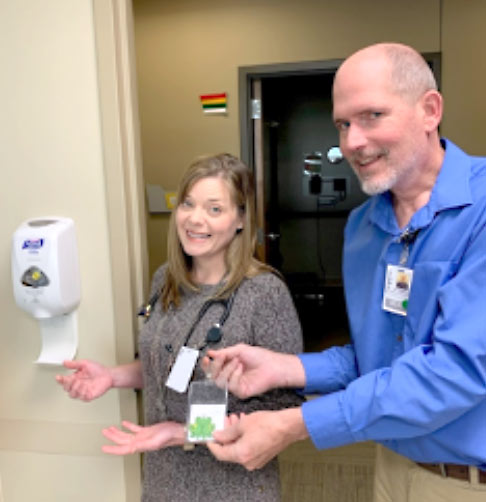
A small, community hospital in northeast Kansas came together with a splash of fun and accountability to create a sustainable culture of safety, especially when it comes to hand hygiene.
As the COVID-19 pandemic made its way across the nation earlier this year, the Hiawatha Community Hospital was wrapping up its participation in a statewide Hand Hygiene Collaborative facilitated by the Kansas Healthcare Collaborative. The nine-month initiative concluded in March, 2020, with more than 60 Kansas hospitals participating.
 Ronna Montgomery, BSN, RN, Director of Risk, Quality and IPaC“The timing couldn’t have been better and sustainability strategies have been key. This has been especially beneficial throughout the COVID-19 pandemic,” said Ronna Montgomery, infection prevention coordinator, director of risk management and quality assurance.
Ronna Montgomery, BSN, RN, Director of Risk, Quality and IPaC“The timing couldn’t have been better and sustainability strategies have been key. This has been especially beneficial throughout the COVID-19 pandemic,” said Ronna Montgomery, infection prevention coordinator, director of risk management and quality assurance.
With support and ideas generated through the collaborative, she designed a creative approach to bring fun to the workplace while making a meaningful change in the way individuals viewed and embraced hand hygiene.
Montgomery described how her team has executed a combination of approaches to create an enduring culture of safety.
One of the things she learned is that making it fun can creates sustainability. “No one wants to buy into something that’s just another task or another thing to mark off a list,” Montgomery said.
Earlier this year, she created a friendly staff competition which encouraged a culture of accountability. She borrowed an idea from hand hygiene peers that utilize a "FROG" mascot representing, Friction Rubs Out Germs. Montgomery made 13 badge ID buttons featuring a cute frog and passed them around to different areas of the hospital with a little memo on them. “Everyone loves a friendly competition around here. If you got caught not washing your hands, you had to wear the badge that day.” Montgomery said the FROG campaign increased awareness across the organization, and that physicians and staff had great fun with it.
- FROG Hand Hygiene flyer
- HCH's Hand Hygiene Project Summary (sample as of 9/30/2019)
 Staff at Hiawatha Community Hospital with the FROG badge.While working to increase hand hygiene observances at their facility, Montgomery reached out to non-clinical staff who worked at the registration desk and other departments. “We tapped all the people that we could think of who are integral to the organization and maybe weren’t perceived as people who would normally observe,” she said. Utilizing a combination of electronic and paper observances meeting individual preferences, Montgomery saw observations increase from 60 to 250 in one month.
Staff at Hiawatha Community Hospital with the FROG badge.While working to increase hand hygiene observances at their facility, Montgomery reached out to non-clinical staff who worked at the registration desk and other departments. “We tapped all the people that we could think of who are integral to the organization and maybe weren’t perceived as people who would normally observe,” she said. Utilizing a combination of electronic and paper observances meeting individual preferences, Montgomery saw observations increase from 60 to 250 in one month.
“Learning what works for our team was half the battle, finding what keeps it interesting and making friendly competitions has worked well for us. I am already working on the next fun game: personal protective equipment,” she said.
Other examples of multiple approaches included encouraging staff members to be observant not only in their own facility, but when visiting others. Being aware of what other hospitals were doing and comparing hand hygiene practices has helped condition their awareness and driven higher adherence to hand hygiene efforts.
The role of the hospital's administrative team and its commitment to hand hygiene solidifies and unifies the priority that hand hygiene is important. The hospital has a monthly Leadership Scorecard, and hand hygiene is at the top of it. Quarterly forums with all staff members provide an opportunity for leadership to champion the message.
 Data and stories help when educating new hires or existing staff, otherwise engaging their team, and sustaining the message.
Data and stories help when educating new hires or existing staff, otherwise engaging their team, and sustaining the message.
“Hardwiring the message is half the battle," Montgomery said. "People tend to get fatigued if they’re only listening to their infection preventionist. Everyone needs to be on board. I suggest if your organization is struggling to find that level of engagement, you enlist those who are in leadership roles—clinical and non-clinical."
Due to the proactive focus, collaboration with KHC, and best practice sharing across the state, the importance of hand hygiene adherence and monitoring has been hardwired.
“This work has been a valuable foundation that has proven to be sustainable in the midst of a surging pandemic," said Montgomery. "As an infection preventionist, I can’t emphasize enough the importance and value of a sustainable hand hygiene program."
Resources:
- KHC Hand Hygiene Resources page
- KHC Hand Hygiene Collaborative education archive
- KHC webinar recording: Bringing Fun to Patient Safety (April 2019)
About Hiawatha Community Hospital
Hiawatha Community Hospital was built in 1951 to serve a community of approximately 3,000 residents in Brown County, Kansas. It is located between the Kickapoo, Iowa, and Sac & Fox reservations in northeast Kansas. The hospital, in partnership with its medical staff and the community, offers a broad range of inpatient and outpatient services to provide resources for education, diagnosis, treatment, and referral in the appropriate settings. Hiawatha Community Hospital received designation as a Level IV Trauma Center in 2019. Hiawatha is known for the hundreds of maple trees that line its streets and is known as the City of Beautiful Maples.
